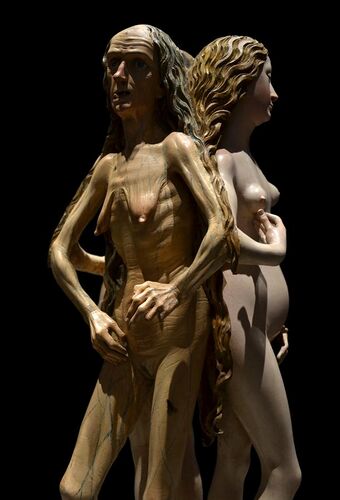Medicine:Breast atrophy
| Breast atrophy | |
|---|---|
 | |
| 15th century sculpture depicting breast atrophy |
Breast atrophy is the normal or spontaneous atrophy or shrinkage of the breasts.[1]
Breast atrophy commonly occurs in women during menopause when estrogen levels decrease.[2][3][4] It can also be caused by hypoestrogenism and/or hyperandrogenism in women in general,[1] such as in antiestrogen treatment for breast cancer, in polycystic ovary syndrome (PCOS),[5][6] and in malnutrition such as that associated with eating disorders like anorexia nervosa or with chronic disease.[1][7][8] It can also be an effect of weight loss.[8][9]
In the treatment of gynecomastia in males and macromastia in women, and in hormone replacement therapy (HRT) for trans men,[10] breast atrophy may be a desired effect.
Examples of treatment options for breast atrophy, depending on the situation/when appropriate, can include estrogens, antiandrogens, and proper nutrition or weight gain.[citation needed]
See also
- Mammoplasia
- Micromastia
References
- ↑ 1.0 1.1 1.2 Prem Puri; Michael E. Höllwarth (28 May 2009). Pediatric Surgery: Diagnosis and Management. Springer Science & Business Media. pp. 257–258. ISBN 978-3-540-69560-8. https://books.google.com/books?id=8A70xzrxK9EC&pg=PA257.
- ↑ Melvin A. Shiffman (24 December 2009). Mastopexy and Breast Reduction: Principles and Practice. Springer Science & Business Media. pp. 42–. ISBN 978-3-540-89873-3. https://books.google.com/books?id=CRzbklu1FFEC&pg=PA42.
- ↑ Kristen A. Atkins; Christina Kong (29 October 2012). Practical Breast Pathology: A Diagnostic Approach: A Volume in the Pattern Recognition Series. Elsevier Health Sciences. pp. 67–. ISBN 978-1-4557-3340-8. https://books.google.com/books?id=8gWxUKXHEGkC&pg=PA67.
- ↑ Thomas J. Lawton (27 April 2009). Breast. Cambridge University Press. pp. 1–. ISBN 978-0-521-88159-3. https://books.google.com/books?id=z17R70VGhnsC&pg=PA1.
- ↑ Ricardo Azziz (3 July 2007). The Polycystic Ovary Syndrome: Current Concepts on Pathogenesis and Clinical Care. Springer Science & Business Media. pp. 20–. ISBN 978-0-387-69248-7. https://books.google.com/books?id=242bPI5OWCQC&pg=PA20.
- ↑ Susan Scott Ricci; Terri Kyle (2009). Maternity and Pediatric Nursing. Lippincott Williams & Wilkins. pp. 213–. ISBN 978-0-7817-8055-1. https://archive.org/details/maternitypediatr0000ricc.
- ↑ J.P. Lavery; J.S. Sanfilippo (6 December 2012). Pediatric and Adolescent Obstetrics and Gynecology. Springer Science & Business Media. pp. 99–. ISBN 978-1-4612-5064-7. https://books.google.com/books?id=l9XTBwAAQBAJ&pg=PA99.
- ↑ 8.0 8.1 Julia A. McMillan; Ralph D. Feigin; Catherine DeAngelis; M. Douglas Jones (2006). Oski's Pediatrics: Principles & Practice. Lippincott Williams & Wilkins. pp. 558–. ISBN 978-0-7817-3894-1. https://books.google.com/books?id=VbjFQiz8aR0C&pg=PA558.
- ↑ Cynthia Feucht; Donald E. Greydanus; Joav Merrick; Hatim A. Omar; Dilip R. Patel (2 April 2012). Pharmacotherapeutics in General, Mental and Sexual Health. Walter de Gruyter. pp. 287–. ISBN 978-3-11-025570-6. https://books.google.com/books?id=wDgkBgAAQBAJ&pg=PA287.
- ↑ Merril D. Smith (8 September 2014). Cultural Encyclopedia of the Breast. Rowman & Littlefield Publishers. pp. 121–. ISBN 978-0-7591-2332-8. https://books.google.com/books?id=qrCCBAAAQBAJ&pg=PA121.
External links
| Classification |
|---|
 |

